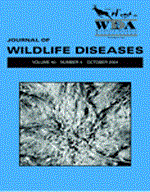We obtained blood smears from 114 Florida sandhill crane (Grus canadensis pratensis) chicks in Osceola and Lake Counties, Florida, USA, during 1998–2000. Leucocytozoon grusi was observed in 11 (10%) chicks; Haemoproteus antigonis was observed in eight (7%) chicks; and three (3%) chicks were infected with Haemoproteus balearicae. One chick infected with H. balearicae suffered from severe anemia (packed cell volume=13%) and was later found moribund. At necropsy this bird also had severe anemia and damage to the heart possibly due to hypoxia. This is the first report of H. balearicae in free-ranging North American cranes.
How to translate text using browser tools
1 October 2004
HAEMOPROTEUS BALEARICAE AND OTHER BLOOD PARASITES OF FREE-RANGING FLORIDA SANDHILL CRANE CHICKS
Robert J. Dusek,
Marilyn G. Spalding,
Donald J. Forrester,
Ellis C. Greiner

Journal of Wildlife Diseases
Vol. 40 • No. 4
October 2004
Vol. 40 • No. 4
October 2004
Anemia
Florida
Grus canadensis pratensis
Haemoproteus antigonis
Haemoproteus balearicae
Leucocytozoon grusi
sandhill crane




